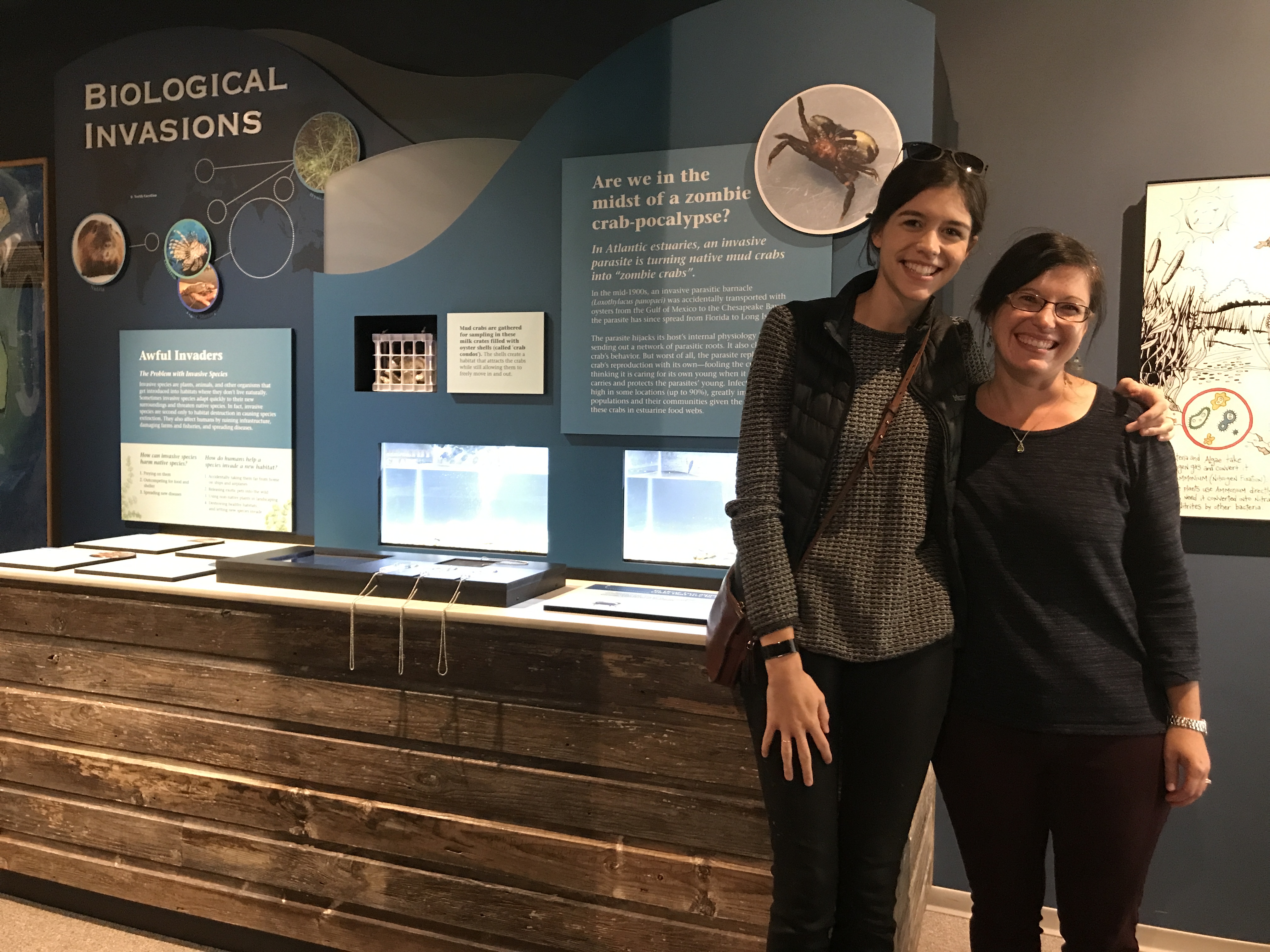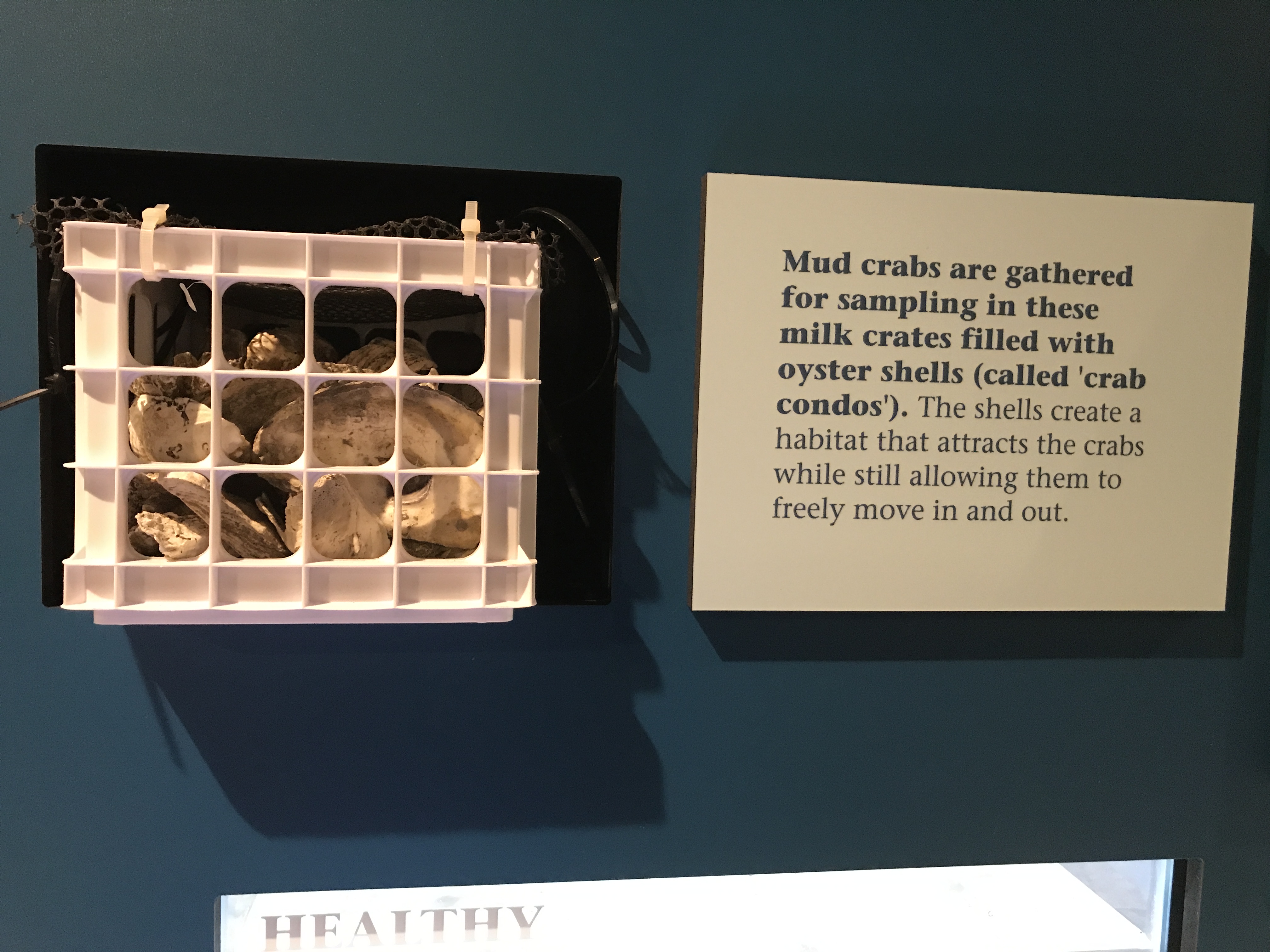Zombies and Invaders in Estuaries, Oh My!
October 2023 Update:
Looking for Halloween themes in real science? This exhibit was funded initially through a Community Collaborative Research Grant from NC Sea Grant, NC Water Resources Research Institute and the Kenan Institute for Engineering, Technology and Science. The research team from East Carolina University and the North Carolina Estuarium have continued to update it over the years. Check below for a research publication from the science behind the exhibit.
By April M.H. Blakeslee
Are we in the midst of a zombie crab-pocalypse?
Just in time for Halloween, this is the question we pose in a new exhibit at the North Carolina Estuarium in Washington, N.C.

The exhibit focuses on biological invasions, an important conservation issue in eastern North Carolina estuaries where salty and freshwater mix. In this case, the culprit is a nonnative parasitic barnacle that infects native mud crabs in Atlantic estuaries.
The implications of such invasions for local ecosystems are not limited to this parasite. Other notable invaders — such as lionfish and Hydrilla — are featured as well.
The “body-snatching” parasite takes over the internal physiology of its crab host, stops the crab from reproducing and changes host behavior so that the crab will care for the parasite’s young as if it were its own.
Even male crabs are affected by this behavioral change, leading to what is referred to as “male feminization.” As a result of these drastic physiological and behavioral changes — to the parasite’s benefit but the crab’s harm — infected crabs often are referred to as zombie crabs.
The innovative exhibit has been featured at the Estuarium’s family events such as the “Estuscarium,” which showcased other critters that “bump, skitter, or crawl.”

The biological invasions exhibit is funded through a North Carolina Sea Grant initiative known as Community Collaborative Research Grants, or CCRG. These grants support partnerships that combine knowledge of community stakeholders with academic experts. Together, the teams address priority coastal issues.
Our team consists of academics — myself and my students — and local experts at the Estuarium: Director Tom Stroud and Russ Chesson, programming specialist. A key member of this partnership is Kayla Clark, an ECU art and design graduate student who designed the exhibit in consultation with the rest of the team.
The truly interdisciplinary exhibit combines art and science to highlight the importance of biological invasions in eastern North Carolina. Specifically, it reveals the critical role research plays in understanding how invasive species affect local communities, as well as the important role that parasites can have in ecosystems.
Our goal is to provide outreach and education about invasive species to local audiences, notably children visiting the Estuarium. Visitors also will learn how they can prevent the spread of invaders by not releasing unwanted pets into area waterways, cleaning boats of attached algae, plants or animals, cleaning boots, etc.
In other words, every person can make a difference in conservation-related efforts.
In addition to the exhibit, the CCRG funding also supports an ongoing research project in my lab at ECU. That work focuses on zombie crabs, and how the abundance of the parasite invader and the crab host might be affected by changing water salinity.
At sites on the Pamlico and Neuse rivers, my undergraduate and graduate students and I conduct surveys every six to eight weeks. We have six sites on each river to reflect the changing salinity from the sound to upstream river waters. Crabs are captured using “crab condos” that attract crabs and other local species to the complex three-dimensional habitats.

Our hypothesis is that parasite abundance will drop as salinity drops along this gradient because the parasite has a more constricted salinity range than the crabs that are the unwitting hosts.
Results of this study will have ecological and evolutionary implications to local estuarine communities. Mud crabs are important members of estuarine food webs. High levels of infection by the parasite can have strong negative impacts on crab populations, as well as the organisms that feed on them.
Additionally, the parasite itself may be an important evolutionary driver of crab resistance to infection, a factor we will consider and document through time. Museum visitors learn about the ongoing research via a tablet slide show that will be updated as the research continues over the next few years.
Sea Grant’s CCRG program is funded through a partnership with William R. Kenan Jr. Institute for Engineering, Technology and Science. The exhibit and our research also have support from the Estuarium and several ECU partners including the Biology Department, Thomas Harriot College of Arts and Sciences, and Division of Research, Economic Development, and Engagement.
We hope to see you on Thursday for the Estuarium’s Halloween event. If you cannot make it, the exhibit will be included as a permanent exhibit at the Estuarium and available to view for years to come.
Teachers — and community leaders interested in incorporating the visit into lessons and programs — can contact the Estuarium for more information.
##
April M.H. Blakeslee is a member of the biology faculty at East Carolina University. She also serves as a researcher at the Marine Invasions Lab at the Smithsonian Environmental Research Center in Maryland, and is on the editorial team for Aquatic Invasions and BioInvasion Records of the Regional Euro-Asian Biological Invasions Centre.
Since the initial blog post, results of this research have been published: Blakeslee AM, Pochtar DL, Fowler AE, Moore CS, Lee TS, Barnard RB, Swanson KM, Lukas LC, Ruocchio M, Torchin ME, Miller AW, Ruiz GM, Tepolt CK. Invasion of the body snatchers: the role of parasite introduction in host distribution and response to salinity in invaded estuaries. Proceedings of the Royal Society B. 2021 Jun 30;288(1953):20210703. Online at: https://doi.org/10.1098/rspb.2021.0703
This project also was featured in a science news story from UNC-TV, and as a blog post from East Carolina University.
##
- Categories:


